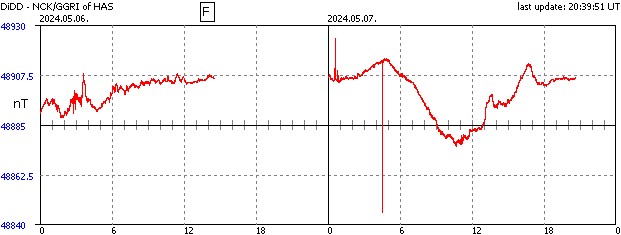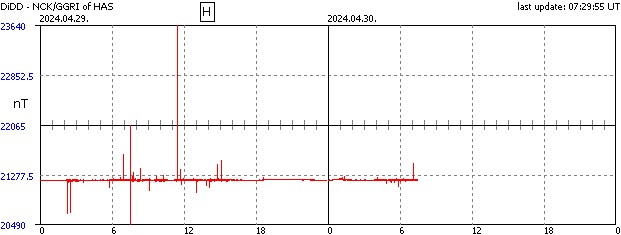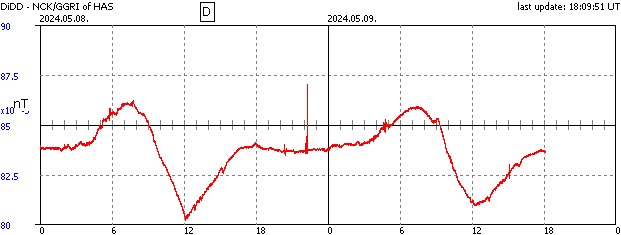Széchenyi István Geophysical Observatory
The Széchenyi István Geophysical Observatory of the Hungarian Academy of Sciences has been supplying data since 1957. The objective of the observatory is to record continuously the Earth's electromagnetic field of external origin. Geophysical Observatory Reports comprise earth current data from 1957 on, geomagnetic data from 1961 on, atmospheric electricity data from 1962 on and ionospheric data from 1967 on. The observatory became involved in the INTERMAGNET program in 1993. This led to stronger cooperation with other observatories, adoption of standard specification for measuring and recording equipments and production of geomagnetic data in close to real time. Data acquisition systems of earth current, atmospheric electricity and ionospheric observations were also modernized and three new measurements such as Schumann resonance, ionosonde and meteorology started during the last ten years.
Description of the observatory
Nagycenk Geophysical Observatory was founded in 1956-57 and it has been operated since then by the Geodetic and Geophysical Institute of the Earth Science Center, Hungarian Academy of Sciences
The observatory is
situated about 10 km to E of the city Sopron and 60 km SE of Vienna ,
on the southern shore of lake Fertő. The observatory lies on thick
conductive sediment preserving the site from far industrial noise and
it is surrounded by the Fertő-Hanság National Park which helps to
shelter the long term measurements from any change caused by nearby
manmade activity.
The coordinates of the observatory:
Geographic coordinates:
j =47° 38'(N)
l =16° 43'(E)
altitude =153.70m (magnetic house)
McIllwain L =1.9
Measurements and reports started in 1957 (International Geophysical Year) with earth current data. As it is customary the potential differences are measured in N-S and E-W directions with electrode spacings of 500m. Low polarization lead plate electrodes are buried about 2 m below the surface. Potential differences are recorded with 1sec and 10 sec sampling rate. Exceptionally long time series cover nearly four solar cycles
Continuous observation of atmospheric electricity started in 1961. Slow variation (DC component of vertical atmospheric electric field) is measured between the ground and an electrode (at 1m height) around which the potential is equalized by means of a radioactive collector. Potential gradient is recorded with 15 sec sampling rate. Point discharge is measured with stainless steel tip mounted on the roof of the atmospheric electricity building.
Since 1967 ionospheric measurements have also been carried out. Lower ionosphere is studied using A3 (oblique incidence, LF radiowave absorbtion) method.
Continuous observation of geomagnetic elements with control of the absolute observations began in 1961. The observatory has belonged to the INTERMAGNET cooperation since 1993. Data are transmitted via METEOSAT satellite to geomagnetic information nodes and made also available to the international research community on CD ROM.
The early nineties are to be considered as a transition period in the observatory again. Surface-ionosphere cavity resonance measurements started in 1994, an ionosonde station type IPS 42 works since 1996 and a scientific meteorological station was installed in 1996. The meteorological station is based on a Campbell CR10X measurement and control modul, temperature, humidity, wind speed, wind direction, rainfall and radiation sensors.
Observatory site diagram

E
Entrance
1 Main building with staff hostel and electronic
laboratory
2 Telluric instruments and office
3 Atmospheric electricity centre (laboratory of
Schumann resonance, potential gradient, point dicharge and radiovawe
absorbtion measurements)
4 Magnetic absolute house with four pillars
5 Underground magnetic variometer chambers
6 Proton magnetometer (D I/D D) hut
7 Computer centre ( data loggers, server of local
network, satellite transmitter)
8 Ionosonde station, electric and mechanical workshop
9 Ionosonde D -antenna
10 Meteorological station
11 ELF induction coil chamber
12 Ball antenna (Schumann resonance antenna)
13 Potential gradient sensors



